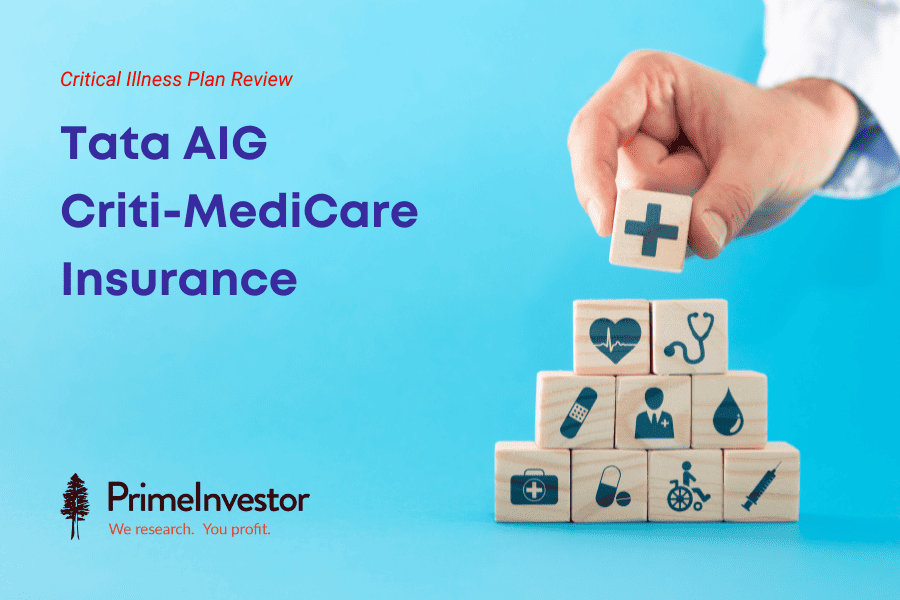We at PrimeInvestor, recommend reinforcing your insurance arsenal with a critical illness cover in addition to a hospitalization plan in order to secure your finances against medical emergencies. We have covered what you should look for when shopping for a critical illness cover in our earlier article titled ‘What to look for in a critical illness health plan’. We have also shortlisted a few critical illness covers in the market based on these criteria and reviewed them in detail.
The plans we have reviewed so far are:
- Activ Secure Critical Illness Plan by Aditya Birla Health Insurance,
- Criti Care policy by Bajaj Alianz General Insurance,
- IFFCO Tokio’s Critical Illness Benefit Policy and
- Star Critical Illness Multipay Insurance Policy.
Here, we add to this list with our review of Tata AIG’s Criti-MediCare Insurance.

Key features
Tata AIG’s Criti-MediCare plan is a relatively new entrant to the critical illness market place, having been launched only in mid-2022. Unlike plain vanilla critical illness covers that payout a lump sum on the first diagnosis of a covered critical illness, this plan comes with 3 ‘base benefit’ sections and one optional benefit section.
- Section A: Critical Illness (base benefit)
- Section B: Cancer 360 degree indemnity cover (base benefit)
- Section C: Hospital Cash (base benefit)
- Section D: Wellassurance (optional)
An insured has to choose at least one base benefit section and section D is entirely optional. So if a critical illness cover is what you are after, then Section A is what you should opt for.
- This section has 2 variants – the ‘Smart Century Premier Plan’ that covers 100 critical illnesses and the ‘Smart Half Century Plan’ that covers 50 critical illnesses.
- Illnesses are further categorized into 3 categories – A / B / C – and an insured is allowed to make a maximum of 3 claims in a lifetime with a maximum of 1 claim per category of illnesses.
- For the critical illness section, the sum insured (SI) can range between Rs. 5 lakh and Rs. 2 crore in each category.
- The sum insured is on an individual basis which means that though family members (self, spouse, dependent children, parents, parents-in-law, grand children, brother, sister, brother-in-law/Sister-in-law, nephew/niece) can be covered under the same policy (all members will get the same sections) each insured will have a separate sum insured.
- The critical illness section comes with the standard 90-day waiting period which also applies for Section B (Cancer 360 degree indemnity cover) if opted for. The waiting period for Section C (Hospital Cash) is 30 days.
- The base survival period requirement is 15 days with an option to reduce it to 7 days or 0 days in exchange for loading of 5% or 7.5% respectively.
- The policy comes with the usual exclusions (alcoholism, drug abuse, self-harm etc.).
- Pre-existing conditions will be covered after a period of 48 months.
- The policy (Section A) is available for ages 18 years to 65 years but it comes with lifelong renewability on timely payment of premium.
- Once you’ve signed up, you can only make enhancements to the SI at the time of renewal and waiting periods will apply afresh to the incremental amount.
- The policy is available for tenures of 1 /2 / 3 years.
- Pre-policy medical may be required depending on age of insured and SI opted for.
- You can also add on a personal accident cover of Rs. 3 lakhs if you have taken the critical illness section.
What we like
#1 Wide coverage of critical illnesses & multi-pay
The biggest advantage of the Critical Illness section of the Criti-MediCare Insurance plan is the wide coverage of illnesses it offers. The Smart Century Premier Plan variant covers 100 listed critical illnesses and the Smart Half Century Plan covers 50. This also covers illnesses such as Alzheimer’s and Parkinsonism and many others that don’t find a place in other critical illness covers.
Further, the division of the illnesses into 3 categories also allows for up to 3 payouts during the lifetime of the policy as long as each of the claims fails under a different category and there is a 60-day gap from the earlier admitted diagnosis of critical illness.
#2 Smart Cancer Care benefit
One criticism that critical illness covers have faced is that most of them do not cover early stage diagnosis of cancer. The Criti-MediCare plan addresses under the ‘Critical Illness’ section or Section A where it pays out a specified percentage of the SI if the insured is diagnosed for the first time with cancer. (20% for early stage; 30% for major stage and 50% for advanced stage). This benefit is over and above the critical illness sum insured. This benefit ceases once a claim for advanced stage cancer has been admitted or 100% of SI for this benefit is used up.
#3 Option to add on additional covers
Section A or the critical illness section is only one of the three base benefits that this plan offers. The plan requires you to take a minimum of one base benefit. One of the other two base benefits is Cancer 360 degree indemnity cover. For this section too the SI can go from Rs. 5 lakh to Rs. 2 crore. This means that if cancer is something that you are keen to cover given your family / medical history, this plan should be on your short list.
#4 Lots of bells & whistles
The Tata AIG Criti-MediCare comes with a lot of smaller but attractive features with the main ones being:
- The ability to shorten the survival period to 7 days or even 0 days in exchange for loading
- Ability to add on covers to a critical illness plan (Cancer indemnity + Hospital Cash + Wellassurance)
- Waiver of premium under the Smart Century Premier Plan option of the Critical Illness section which waives 70% of the renewal premium for the next three policy years in case the first claim has been admitted
- Discounts on premium (10% when one opts for 3 years and 5% for 2 years, 7.5% when >2 indivduals are covered, 2.5% when more than one section is opted for, 2.5% if insured has any other active Tata AIG plan)
What we don’t like
You guessed it. What we don’t like about this plan is how complicated it is. Sections, categories, variants and options means that you will be reading the wordings at least a few times to ensure you’ve understood it properly. It can also mean that in the event that you do need to make a claim, you are re-reading it to confirm where your claim falls and how much your payout will be.
But this is a common flaw we have observed with critical illness plans that seek to cover a wider range and seriousness of illnesses as also in the case of the Activ Secure Critical Illness Plan by Aditya Birla Health Insurance Co. Ltd.
While the benefits are attractive, we found that the wordings of the plan leave some room for interpretation. For instance, the information for ‘Smart Cancer Care’ benefit says that the sum assured for this benefit is ‘separate and over and above the critical illness sum insured’. One would need to clarify on what the sum insured for this benefit is and how exactly this benefit would work ‘over and above’ given that cancer is also one of the critical illnesses covered.
Asking for clarifications and illustrations would be essential, if you are considering this plan.
About the Insurer
Tata AIG has been around since 2001 and is a joint venture between the Tata Group that needs no introduction and the American International Group. While the fact that it is a part of the house of Tata gives some comfort on the strength of the insurer, in terms of the size of the business, it is smaller than many of the other large private players.
- The company has a claims settlement by value of only 80.29% based on data for the year ending on March 2022. While this is not bad, what it means is large claims may not be paid out in full.
- The other thing that we are not entirely happy with is the claims settlement efficiency ratio which measures the proportion of claims settled within 3 months for March 2022 which stands at 91.22%. While this by itself looks like a good number, almost all other players have better numbers for this metric.
- Tata AIG has in the past also had a notoriously high claims repudiation ratio especially for health insurance. IBAI’s Insurance Claims Insights places this at 24.14% for the year ended on March 31, 2021 which means it is likely that one in four claims could get rejected. This is not what you want to deal with especially when a health crisis strikes. However, more recent data suggest that this is now closer to 10%.
You can read more about what these metrics mean and how they should influence your choice in our earlier article ‘Which insurers settle your claims the best’.
Suitability
The biggest advantage of the Tata AIG Criti-MediCare is the breadth of coverage it offers (100 critical illnesses + multi pay + the ability to add on a cancer specific indemnity cover). If this is what you need given your family and / or medical history, then this plan should definitely figure on your shortlist as none of the plans we have reviewed till now match up in terms of the coverage offered by the Smart Century Premier.
So you should consider this if:
- You want a plan that has a wide coverage and the possibility of more than one payout
- You want to be able to add on a cancer specific cover
- You are comfortable with the structure
But you should be mindful of the following and should:
- be comfortable with its complex structure and get as many clarifications as you require so you fully understand how it works before signing up for it. Don’t hesitate to ask for various illustrations as well to understand how the various scenarios could play out for you.
- make sure that you understand the various terms and conditions especially on the stages of the illness that would qualify for a payout in order to avoid any unpleasant surprises if at all a crisis were to strike.
- be careful to not take more of the optional coverages than you need. If you already have a comprehensive health plan and are supplementing with a critical illness cover, the Hospital Cash and Wellassurance may be an overkill. Likewise, evaluate your requirement for the cancer indemnity cover against your family and medical history.
- Note that the personal accident cover too which offers a payout of Rs. 3 lakh will likely be insufficient and you will be better off opting for a separate personal accident cover.
Premiums for a cover of Rs. 10 lakhs without health check-up for survival period of 15 days would look like this:
- Bajaj Allianz Criti Care Policy that covers 43 illnesses across 5 sections and two stages (early and advanced) costs Rs. 1,490 for a 26 to 35-year old and Rs. 3,780 for a 36 to 40-year old. Here, the Smart Half Century which is the more comparable option is more expensive.
- Star Critical Illness Multipay Insurance Policy that covers 37 illnesses across 4 categories costs Rs. 1,870 for a 26 to 30-year old and 3,900 for a 36 to 40-year old. Here too, it seems like the Criti-MediCare is a more expensive option.
- Activ Secure Critical Illness Plan’s Plan 2 that covers 50 critical illnesses costs Rs. 2,826 for a 30-year old and Rs. 6,186 for a 40-year old seems comparable on the cost front with the Smart Half Century Plan.
What is worth noting while making this premium comparison is that while it seems like the Criti-MediCare could be expensive, the differential between the Smart Half Century and Smart Century Premier is not prohibitive and one can justify the higher premium with the wider coverage that Criti-MediCare (100 critical illnesses) offers which should be the primary reason for considering this plan.
As always, do go through the fine print in the policy wordings, if possible with your doctor, to see if there is anything that could work against you (in view of your personal medical history). Do consider the exclusions and various criteria to be met under each critical illness for a claim payout to be made especially in the context of the repudiation ratio that used to be on the higher side.
Important documents relating to this policy: Policy brochure, premium chart, policy wording, prospectus, customer information sheet.
Disclaimer: Please note that the above is only a review of the plan based on publicly available information and not a recommendation. Please make a decision based on your requirements.







4 thoughts on “Critical Illness plan review: Tata AIG Criti-MediCare Insurance”
Which among these policies are the best, if the premium amount is not an issue. If you can suggest the top 1,2. The age would be 35-50. Can you also throw some light on the claim procedure, if its online or offline and other details.
Hello Sir,
Unfortunately, we cannot narrow down simply to top 1 or 2 plans. You will have to choose based on the ‘suitability’ that we cover in our reviews to determine if the plan works for you or not. A large part of whether a plan is good for you or not depends on how much cover you are looking for and what illnesses you are looking to cover. All of this would depend on your personal circumstances and history. Do take into consideration the pointers in the ‘suitability’ section to help you decide.
Details on the claims procedure can be found in page 17 of the prospectus document, which can be found here and the link to which is also provided at the end of the review.
Hope this helps.
Hello PI Team,
Trying to see what the merit is in getting a critical illness cover, if you have medical insurance and top-up policies. Goal is to have financial impact known(infact limited) in case of unplanned medical expenses. Trying to ascertain if there are any circumstances or situation where Critical illness cover is required and top-up/super-topup will not suffice.
Top-up policies will cover all the condition which is superset of critical illness list.
Thanks
Hello Sir,
A critical illness cover, unlike hospitalisation (indemnity) covers pays out a pre-determined sum on the diagnosis of a covered critical illness. So irrespective of what you spend on managing the critical illness the payout will be made for the sum insured. This is important because in the case of a critical illness the risk is that not only will there be medical expenses (not just in a hospital but also possible home care etc) but also a likely loss of income. A critical illness cover will protect your finances against these risks. These two articles will throw more light.
1. How much health insurance do you need?
2. What to look for in a critical illness cover?
Hope this helps.
Comments are closed.